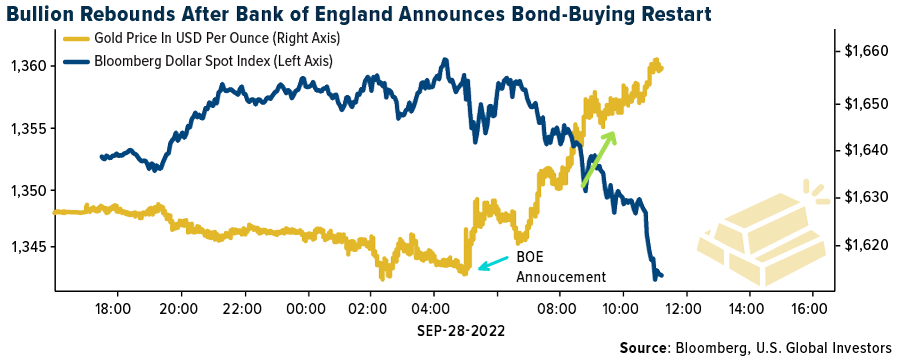Strengths
- The best performing precious metal for the week was palladium, up 4.90%, on what looks to be a firmer picture for precious metals recently. Palladium production was already restrained with recent flooding near the Stillwater mine, and this week the South African miners warned of possible supply issues related to power availability.
- Barrick Gold Corp.’s long-term profile at NGM highlights 3.5 million ounces of production consistently over 15 years. This represents a meaningful improvement from the 2018 plan prior to the formation of NGM, and an extension of production from the current-published, 10-year plan to 2031. This upside is driven by near-mine resource extension, which is viewed as being relatively straightforward given the existing infrastructure in place and an improved geological understanding of the asset base.
- According to BMO, Newmont has sold its 18.75% stake in the MARA copper-gold project to joint venture partner Glencore for $124.9 million up-front, plus $30-$50 million on achieving commercial production. This purchase price is well above the $67 million consensus value.
Weaknesses
- The worst performing precious metal for the week was platinum, but still up 0.09%. As of Thursday’s close, total holdings in gold ETFs show that investors remain in redemption mode in regard to the yellow metal. However, the price of gold today is slightly higher than the day before the Federal Reserve raised interest rates.
- The latest European Union sanctions package against Russia did not include a ban on diamond imports from Russia, for its invasion of Ukraine, as reported in the Brussels Times. The proposed ban would cut off an additional €7 billion of Russian imports but rough diamonds were not included in the final list. Belgium is one of the larger Russian diamond buyers.
- Labor remains tight – this is broadly viewed as the next leg to drop, inflation wise, in mining. Newmont has 500 openings for workers at NGM and the younger generation appears not to be as keen to work in mining, despite average wages being triple that of Vegas jobs. Skilled labor (engineers, etc.) is even harder to come by. Mining labor costs are proving fairly steady (not seeing a huge demand for big raises).
- Despite a 75-basis point interest rate hike by the Fed last week and a surging U.S. dollar, there are other factors emerging that support gold. The Bank of Japan spent $19.7 billion last month to slow the yen’s slide against the U.S. dollar. Gold got a second boost this week from earlier losses, reports Bloomberg, after the Bank of England (BOE) restarted its pandemic-era bond buying program, citing a risk to the U.K.’s financial stability as the pound plunged to record lows on the newly proposed budget.

- Investors poured money back into precious metals stocks over the past week on the heightened risk of a policy mistake, particularly as other central banks struggle with their devalued currencies. Silver mining stocks were some of the best performers over the past week. The relative strength indicator for major gold stocks touched its oversold line on September 27 and investors reacted. Bloomberg reported that the price of deeper, out-of-the-money insurance in equities is falling, implying lower demand for crash insurance. Its analysis suggests that the market believes the Fed put is getting closer. Any deviation from the current telegraphed interest rate path forward would likely trigger money flows back into gold.
- Skeena is developing its 100%-owned Eskay Creek Gold/Silver Project in the Golden Triangle of northwestern British Columbia that hosts a total resource of 5.6 million ounces of gold, including open pit reserves of 3.9 million ounces at 4 grams per ton gold. Earlier this month, the company announced results of a feasibility study that confirms Eskay Creek is the premier, undeveloped open pit, precious metals project in Canada.
Threats
- Bloomberg reports that the biggest platinum miners are dealing with an unreliable power supply that has disrupted operations. Electricity is critical to keeping the mines ventilated and running refrigeration systems to cool the air. Eskom, which manages the grid, implemented Stage 4 on September 10, taking 4,000 megawatts from the grid. The industry noted that if this continues it will hit mine output and there will be consequences in terms of jobs.
- Gold may face another difficult week, with holdings in bullion-backed ETFs at risk of contracting to the lowest level in more than two years. Should the dollar hold its ground or manage another push higher, further sales of paper gold may herald a test of $1,600 per ounce. Worldwide holdings in ETFs are on course for a fifth monthly drop in September as the Fed’s stance, U.S. currency’s ascent, and positive real rates dull the metal’s allure.
- NBF reports that current math indicates that IAMGold’s current level would be 8% shy for maintaining its membership in the S&P/TSX Composite Index. Its membership in the NYSE Arca GDM Index (GDX ETF) may be at risk too if its full market cap falls below $450 million by early December – deletion from the GDM would add on an additional supply of est. 26.4 million shares.

